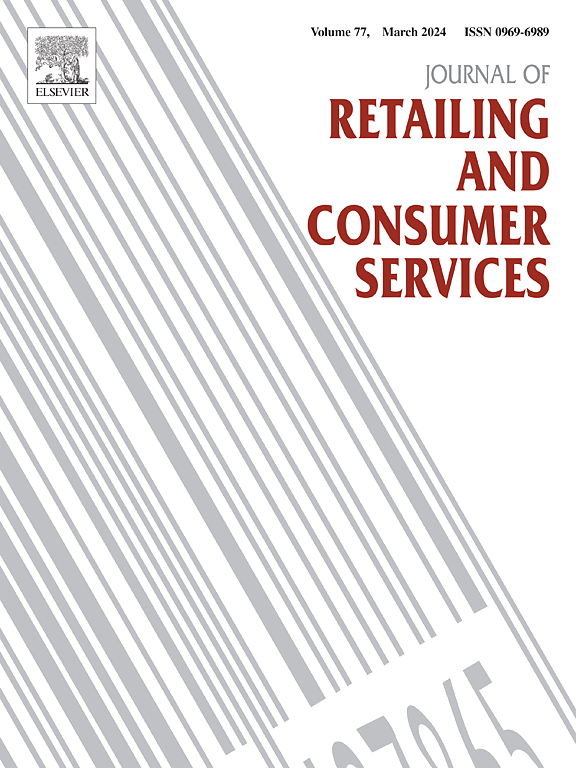弹性需求和数量依赖运输成本下零售商竞争的一般框架
IF 11
1区 管理学
Q1 BUSINESS
Journal of Retailing and Consumer Services
Pub Date : 2025-06-10
DOI:10.1016/j.jretconser.2025.104358
引用次数: 0
摘要
本文扩展了经典的Hotelling模型,解决了两个关键的限制:完全非弹性需求的假设和排除数量依赖的运输成本。传统模型无法捕捉关键的市场动态,因为消费者的购买行为取决于价格敏感性和随购买数量而变化的运输成本。虽然之前的研究将弹性需求纳入了空间竞争,但它们往往依赖于特定的需求函数,并假设与数量无关的运输成本,限制了它们对不同市场情景的适用性。为了解决这些差距,我们提出了一个通用的弹性需求框架和一个新的运输成本函数,该函数依赖于距离和购买量,引入了运输成本相对于数量的弹性作为一个关键参数。这种双重延伸强调了存储差异化、需求弹性和运输成本弹性如何共同影响均衡价格和利润。我们的研究结果表明,与经典的Hotelling模型一致,价格和利润随着商店的差异化而增加。较高的需求弹性会加剧竞争,降低价格和利润,而较高的运输成本弹性会阻碍消费者外出购买大件商品,尤其是大件商品,从而减少竞争。相反,对于运输成本敏感性较低的轻质货物,竞争更加激烈,导致价格和利润下降。通过整合需求和运输成本弹性,我们的模型弥补了空间竞争文献中的重大空白,并为不同产品类别的定价策略提供了可操作的见解。这些发现促进了理论认识,并为零售定价和市场政策提供了实践指导。本文章由计算机程序翻译,如有差异,请以英文原文为准。
A general framework for retailer competition under elastic demand and quantity-dependent transport costs
This paper extends the classic Hotelling model by addressing two critical limitations: the assumption of perfectly inelastic demand and the exclusion of quantity-dependent transport costs. Traditional models fail to capture key market dynamics where consumer purchasing behavior depends on both price sensitivity and transport costs that vary with the quantity purchased. While prior studies have incorporated elastic demand into spatial competition, they often rely on specific demand functions and assume quantity-independent transport costs, limiting their applicability to diverse market scenarios. To address these gaps, we propose a general elastic demand framework and a novel transport cost function that depends on both distance and purchase quantity, introducing the elasticity of transport costs with respect to quantity as a key parameter. This dual extension highlights how store differentiation, demand elasticity, and transport cost elasticity jointly influence equilibrium prices and profits. Our findings demonstrate that, consistent with the classic Hotelling model, prices and profits increase with store differentiation. Higher demand elasticity intensifies competition, lowering prices and profits, whereas higher transport cost elasticity reduces competition by discouraging consumers from traveling for larger purchases, particularly for bulky goods. Conversely, for lightweight goods with low transport cost sensitivity, competition is more intense, leading to lower prices and profits. By integrating demand and transport cost elasticities, our model bridges significant gaps in spatial competition literature and provides actionable insights for pricing strategies across diverse product categories. These findings advance theoretical understanding and offer practical guidance for retail pricing and market policy.
求助全文
通过发布文献求助,成功后即可免费获取论文全文。
去求助
来源期刊
CiteScore
20.40
自引率
14.40%
发文量
340
审稿时长
20 days
期刊介绍:
The Journal of Retailing and Consumer Services is a prominent publication that serves as a platform for international and interdisciplinary research and discussions in the constantly evolving fields of retailing and services studies. With a specific emphasis on consumer behavior and policy and managerial decisions, the journal aims to foster contributions from academics encompassing diverse disciplines. The primary areas covered by the journal are:
Retailing and the sale of goods
The provision of consumer services, including transportation, tourism, and leisure.

 求助内容:
求助内容: 应助结果提醒方式:
应助结果提醒方式:


